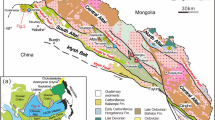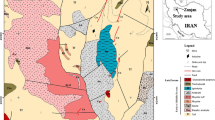Abstract
The Ganboke mineralized district in the Pala area in the southern part of Chad is largely located in the Precambrian greenstone belt. The gold mineralization occurs commonly as auriferous quartz veins (<0.6 m thick) together with networks or stockworks, which are spacially associated with shear zones trending N30°–45°E within greenstone. Paragenetic and micro-structural relationships of vein minerals reveal that gold-bearing veins might have emplaced during syn-deformation events within the shear zones. Gold occurs mainly as free grains (usually less than 0.5 mm in diameter) in white to grey quartz, together with finegrained disseminates of base metal sulfides. Au contents of vein quartz samples are variable within the concentration range of 0 to 2,946 ppm. Fluid inclusion study indicates that homogenization temperatures range from 200 to 400°C with salinities of less than 8 wt% eq. NaCl. The mean value of CO2 content is 17 mole percent. Phase separation of fluids by CO2 effervescence intensely occurred around 350°C and was linked to deposition of ore including gold. The estimated minimum pressure of mineralization is 0.8–1.6 kbars, based on the calculation of XCO2. Thermodynamic considerations show that ore minerals were dominantly deposited from the fluid evolved from an initial high temperature (near 380°C, log fS2=−5 atm) to a later low temperature (270°C, log fS2=−9 atm). The fluid's isotopic compositions (δD=−53.8 to −19.2‰ and δ18O=6.7 to 14.8‰) overlap the range of the metamorphic and primary magmatic waters and are similar to those of many plutonic-volcanic-hosted Archean gold deposits. However, more18O-depleted signature of the ore fluids for the deposits from the Ganboke South district indicate the involvement of meteoric water in the formation of ore deposits.
Similar content being viewed by others
References
Barton, P.B., Jr. and Toulmin, P. III, 1964, The electrum tarnish method for determination of the fugacity of sulfur in laboratory sulfide systems. Geochimica et Cosmochimica Acta, 33, 841–857.
Bohlke, J.K. and Kistler, R.W., 1986, Rb−Sr, K−Ar and stable isotope evidence for the age and source of fluid components of gold bearing quartz vein in northern Sierra Nevada foothills metamorphic belt. Economic Geology, 81, 286–422.
Bowers, T.S. and Helgeson, H.C., 1983a, Calculation of the thermodynamic and geochemical consequences of non-ideal mixing in the system H2O−CO2−NaCl on phase relations in geologic system: equation of statue for H2O−CO2−NaCl fluids at high pressures and temperatures. Geochimica et Cosmochimica Acta, 47, 1247–1275
Bowers, T.S. and Helgeson, H.C., 1983b, Calculation of the thermodynamic and geochemical consequences of non-ideal mixing in the system H2O−CO2−NaCl on phase relations in geologic system: metamorphic equilibria at high pressures and temperatures. American Mineralogist, 68, 1059–1075.
Boyle, R.W., 1961, The geology, geochemistry, and origin of gold deposits of the Yellowknife district. Canada Geological Survey Membership, 310, 190 p.
Brown, P.E. and Lakind, J.S., 1986, Fluid inclusion study of selected quartz veins, Red Lake gold camp, northwest Ontario, Canada. Unpublished manuscript, 44 p.
Burrows, D.R., Wood, P.C. and Spooner, E.T.C., 1986, Carbon isotope evidence for a magmatic origin for Archean gold quartz vein ore deposit. Nature, 321, 851–854.
Burruss, R.C., 1981, Analysis of the phase equilibria in C−O−H−S fluid inclusions. Mineralogical Association of Canada Short Course Handbook, 6, 39–74.
Collins, P.F., 1979, Gas-hydrates in CO2-bearing fluid inclusions and the use of freezing data for estimation salinity. Economic Geology, 74, 1435–1444.
Craig, H., 1961, Isotopic variations in meteoric waters. Science, 133, 1702–1703.
Crawford, M.L., 1981, Fluid inclusion in metamorphic rock-Low and medium grade. In: Hollister, L.S. and Crawford, K.L. (eds.), Short Course on Fluid Inclusion: Applications to Petrology. Mineralogical Association of Canada, vol. 5, p. 157–181.
Emmons, W.H., 1937, Gold deposits of the world. McGraw-Hill Book Company Inc., New York, 562 p.
Gehrig, M., 1980, Phasengleichgewichte unt PVT-Daten tern rer mischungen aus kohlendioxid und natriumchlorid bis 3 kbars und 500°C, Ph.D. thesis, Hochschulverlag, W. Germany.
Groves, D.I. and Phillips, G.N., 1987, The genesis of tectonic setting of Archean gold deposits of the western Austrarian shield—a metamorphic replacement model. Ore Geology Reviews, 2, 287–322.
Henley, R.W., 1973, Solubility of gold in hydrothermal chloride solutions. Chemical Geology, 11, 73–87.
Kerrich, R., 1983, Geochemistry of gold deposit in the Abitibi greenstone belt. Canadian Institute Mining Metallurgy Special Volume 27, p. 48–71.
Kerrich, R. and Fryer, B.J., 1979, Archean precious-metal hydrothermal systems, Dome mine, Abtibi greenstone belt. II REE and oxygen isotope relations. Canadian Journal of Earth Sciences, 16, 440–458.
Kerrich, R. and Hodder, R.W., 1982, Archean lode gold and base metal deposits: evidence for metal separation into separate hydrothermal system. In: Hodder, R.W. and Petruk, E. (eds.), Geology of Canadian Gold Deposits. Canadian Institute of Mining and Metallurgy, Special Volume 24, p. 144–160.
Matsuhisa, Y., Goldsmith, J.R. and Clayton, R.N., 1979, Oxygen isotope fractionation in the system quartz-albite-anorthite-water. Geochimica et Cosmochimica Acta, 43, 1131–1140.
McNeil, A.M. and Kerrich, R., 1986, Archean lamprophyre dykes and gold mineralization, Matheson, Ontario: the conjunction of LILE-enriched mafic magmas, deep crustal structures, and gold concentration. Canadian Journal of Earth Sciences, 23, 324–343.
Ohmoto, H. and Rye, R.O., 1979, Isotopes sulfur and carbon. In: Barnes, H.L. (ed.), Geochemistry of Hydrothermal Ore Deposits (2nd ed.). Wiley Inc., New York, 509–567.
Potter, R.W. III, Clynne, M.A. and Brown, D.L., 1978, Freezing point depression of aqueous sodium chloride solutions. Economic Geology, 73, 284–285.
Schwartz, M.O., 1989, Determining phase volumes of mixed CO2−H2O inclusions by using microthermometric measurements. Mineralium Deposita, 24, 43–47.
Scott, S.D. and Barnes, H.L., 1971, Sphalerite geothermometry and geobarometry. Economic Geology, 66, 653–669.
Touret, J. and Dietvorst, P., 1983, Fluid inclusions in high-grade anatectic metamorphites. Journal of the Geological Society of London, 140, 635–649.
Wood, P.C., Burrows, D.R., Thomas, A.V. and Spooner, E.T.C., 1986, McIntyre-Hollinger Au-quartz vein system, Timmins, Ontario, Canada: Geologic characteristics, fluid properties and light stable isotope geochemistry. In: MacDonald, A.J., (ed.), Proceedings of the International Symposium on the Geology of Gold, Consult International Inc., Toronto, 517 p.
Author information
Authors and Affiliations
Corresponding author
Rights and permissions
About this article
Cite this article
Kim, SY., Chi, SJ. Fluid inclusion and stable isotope studies of gold deposits in the Gamboke mineralized district, Pala area, Chad. Geosci J 5, 27–45 (2001). https://doi.org/10.1007/BF02910171
Received:
Accepted:
Issue Date:
DOI: https://doi.org/10.1007/BF02910171




